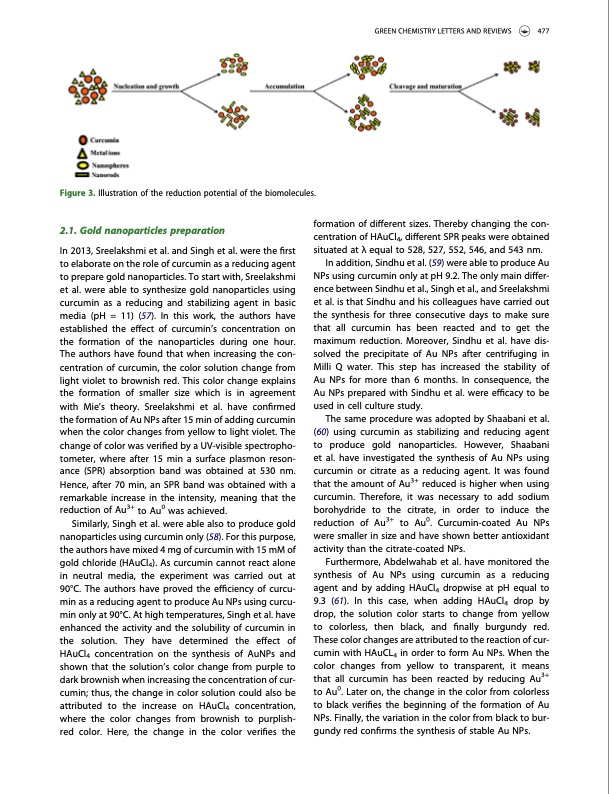
PDF Publication Title:
Text from PDF Page: 005
Figure 3. Illustration of the reduction potential of the biomolecules. 2.1. Gold nanoparticles preparation In 2013, Sreelakshmi et al. and Singh et al. were the first to elaborate on the role of curcumin as a reducing agent to prepare gold nanoparticles. To start with, Sreelakshmi et al. were able to synthesize gold nanoparticles using curcumin as a reducing and stabilizing agent in basic media (pH = 11) (57). In this work, the authors have established the effect of curcumin’s concentration on the formation of the nanoparticles during one hour. The authors have found that when increasing the con- centration of curcumin, the color solution change from light violet to brownish red. This color change explains the formation of smaller size which is in agreement with Mie’s theory. Sreelakshmi et al. have confirmed the formation of Au NPs after 15 min of adding curcumin when the color changes from yellow to light violet. The change of color was verified by a UV-visible spectropho- tometer, where after 15 min a surface plasmon reson- ance (SPR) absorption band was obtained at 530 nm. Hence, after 70 min, an SPR band was obtained with a remarkable increase in the intensity, meaning that the reduction of Au3+ to Au0 was achieved. Similarly, Singh et al. were able also to produce gold nanoparticles using curcumin only (58). For this purpose, the authors have mixed 4 mg of curcumin with 15 mM of gold chloride (HAuCl4). As curcumin cannot react alone in neutral media, the experiment was carried out at 90°C. The authors have proved the efficiency of curcu- min as a reducing agent to produce Au NPs using curcu- min only at 90°C. At high temperatures, Singh et al. have enhanced the activity and the solubility of curcumin in the solution. They have determined the effect of HAuCl4 concentration on the synthesis of AuNPs and shown that the solution’s color change from purple to dark brownish when increasing the concentration of cur- cumin; thus, the change in color solution could also be attributed to the increase on HAuCl4 concentration, where the color changes from brownish to purplish- red color. Here, the change in the color verifies the formation of different sizes. Thereby changing the con- centration of HAuCl4, different SPR peaks were obtained situated at λ equal to 528, 527, 552, 546, and 543 nm. In addition, Sindhu et al. (59) were able to produce Au NPs using curcumin only at pH 9.2. The only main differ- ence between Sindhu et al., Singh et al., and Sreelakshmi et al. is that Sindhu and his colleagues have carried out the synthesis for three consecutive days to make sure that all curcumin has been reacted and to get the maximum reduction. Moreover, Sindhu et al. have dis- solved the precipitate of Au NPs after centrifuging in Milli Q water. This step has increased the stability of Au NPs for more than 6 months. In consequence, the Au NPs prepared with Sindhu et al. were efficacy to be used in cell culture study. The same procedure was adopted by Shaabani et al. (60) using curcumin as stabilizing and reducing agent to produce gold nanoparticles. However, Shaabani et al. have investigated the synthesis of Au NPs using curcumin or citrate as a reducing agent. It was found that the amount of Au3+ reduced is higher when using curcumin. Therefore, it was necessary to add sodium borohydride to the citrate, in order to induce the reduction of Au3+ to Au0. Curcumin-coated Au NPs were smaller in size and have shown better antioxidant activity than the citrate-coated NPs. Furthermore, Abdelwahab et al. have monitored the synthesis of Au NPs using curcumin as a reducing agent and by adding HAuCl4 dropwise at pH equal to 9.3 (61). In this case, when adding HAuCl4 drop by drop, the solution color starts to change from yellow to colorless, then black, and finally burgundy red. These color changes are attributed to the reaction of cur- cumin with HAuCL4 in order to form Au NPs. When the color changes from yellow to transparent, it means that all curcumin has been reacted by reducing Au3+ to Au0. Later on, the change in the color from colorless to black verifies the beginning of the formation of Au NPs. Finally, the variation in the color from black to bur- gundy red confirms the synthesis of stable Au NPs. GREEN CHEMISTRY LETTERS AND REVIEWS 477PDF Image | Curcumin as a novel agent for metallic nanoparticles

PDF Search Title:
Curcumin as a novel agent for metallic nanoparticlesOriginal File Name Searched:
Curcumin-nanoparticles.pdfDIY PDF Search: Google It | Yahoo | Bing
CO2 Organic Rankine Cycle Experimenter Platform The supercritical CO2 phase change system is both a heat pump and organic rankine cycle which can be used for those purposes and as a supercritical extractor for advanced subcritical and supercritical extraction technology. Uses include producing nanoparticles, precious metal CO2 extraction, lithium battery recycling, and other applications... More Info
Heat Pumps CO2 ORC Heat Pump System Platform More Info
| CONTACT TEL: 608-238-6001 Email: greg@infinityturbine.com | RSS | AMP |